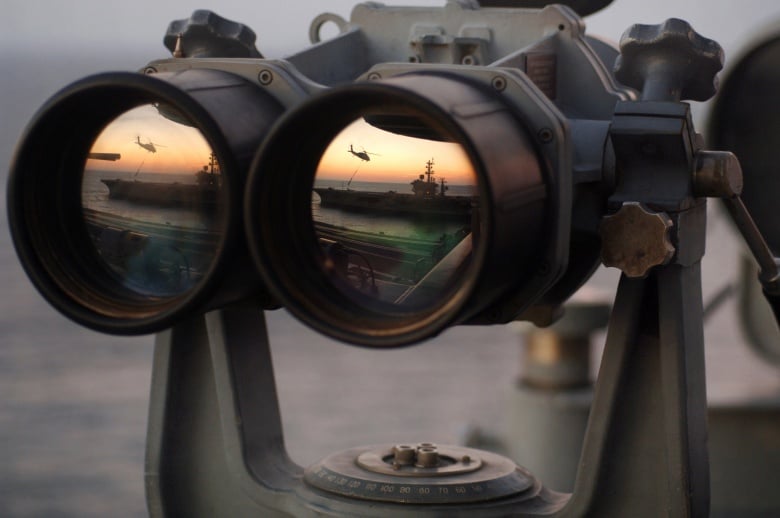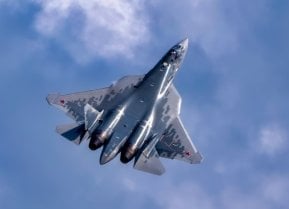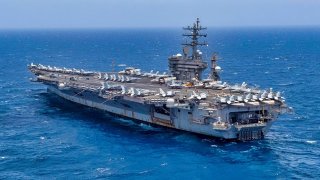USS Dwight D. Eisenhower: The U.S. Navy's Indispensable Aircraft Carrier
The USS Dwight D. Eisenhower (CVN-69), the U.S. Navy’s second-oldest nuclear-powered aircraft carrier, will remain in the Red Sea for an additional month to protect commercial shipping.
Summary: The USS Dwight D. Eisenhower (CVN-69), the U.S. Navy’s second-oldest nuclear-powered aircraft carrier, will remain in the Red Sea for an additional month to protect commercial shipping.

-Originally deployed in October 2023, the carrier and its strike group, including the guided-missile cruiser USS Philippine Sea and destroyers USS Mason and USS Gravely, have conducted operations in the region under the U.S. 5th Fleet.
-The extension follows recent Houthi rebel attacks on commercial vessels in the area.
USS Dwight D. Eisenhower Extends Deployment in Red Sea Amid Tensions
The United States Navy's second-oldest nuclear-powered aircraft carrier will remain deployed in the Red Sea to protect commercial shipping in the region for at least another month. Late last month, United States Secretary of Defense Lloyd Austin extended the deployment of Nimitz-class supercarrier USS Dwight D. Eisenhower (CVN-69) and her strike group.
CVN-69 recently returned to the Red Sea after a brief deployment to the Eastern Mediterranean. The carrier and units of her carrier strike group (IKECSG) – including the Flight II Ticonderoga-class guided-missile cruiser USS Philippine Sea (CG-58), and the Arleigh Burke-class guided-missile destroyers USS Mason (DDG-87) and USS Gravely (DDG-107) – departed their homeports of Norfolk, Virginia, and Mayport, Florida, on Oct. 13 & 14.
The carrier strike group consists of approximately 6,000 sailors.
IKECSG initially arrived in the region as part of a scheduled deployment to the region, but since last fall conducted operations as part of the U.S. 5th Fleet in the Red Sea, Bab Al-Mandeb Strait, Gulf of Aden, and Arabian Gulf including Operation Prosperity Guardian and self-defensive strikes into Iranian-backed Houthi-controlled areas of Yemen.
The Associated Press reported on Friday that a normal warship deployment averages around seven months, which was reached in the middle of May. However, Secretary Austin previously approved the first order to extend the deployment of the carrier strike group about four weeks ago. The news wire also noted that about 12% of the world's trade passes through the waters of the Red Sea and the Gulf of Aden, which first have came attack last November.
Yemen's Houthi rebels have targeted commercial vessels, claiming it is in response to Israel's ongoing offensive in Gaza. However, most of the cargo ships targeted by the Iranian-back group have little to no connection with Israel, the United States, or its partners.

The Houthis have alleged twice in recent days that they have targeted USS Dwight D. Eisenhower and her escorts with drones and missiles, and made the dubious claim that they achieved multiple "direct hits" on the carrier and a destroyer. The United States Central Command (CENTCOM) has not addressed the Houthi claims directly, but said via a statement that it had shot down multiple Houthi munitions.
CVN-69 will continue to operate in waters that should be familiar to the vessel if not the entire crew. As previously reported the ship's first deployment – dubbed Operation Eagle Claw – was during the 1980 Iran hostage crisis, and it operated in the region. One of the carrier's most notable deployments also took place during Iraq's invasion of Kuwait in 1990, during which she became the second nuclear-powered carrier ever to transit the Suez Canal.
CVN-69 has been deployed for more than 200 days as of the beginning of May, and will now remain in the Red Sea a bit longer.
Author Experience and Expertise: Peter Suciu
Peter Suciu is a Michigan-based writer. He has contributed to more than four dozen magazines, newspapers, and websites with over 3,200 published pieces over a twenty-year career in journalism. He regularly writes about military hardware, firearms history, cybersecurity, politics, and international affairs. Peter is also a Contributing Writer for Forbes and Clearance Jobs. You can follow him on Twitter: @PeterSuciu. You can email the author: [email protected].
Image Credit: Creative Commons.


